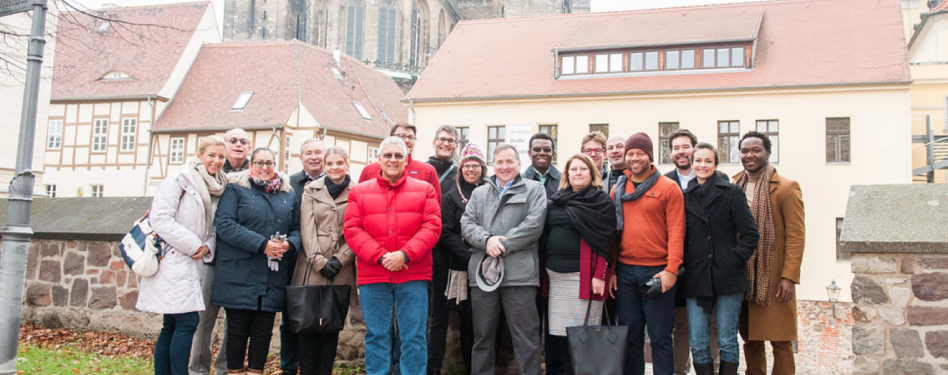
Credit for all photos: RLJ Photography.
A trip to Germany in the fall of 2017 only opened my eyes to the great work being done globally to enable smarter, cleaner mobility. It also provided me with a clearer vision of parking’s role in the sustainable mobility systems of tomorrow. With transport representing almost a quarter of Europe's greenhouse gas emissions, my work with Parksmart—the world’s only rating system advancing sustainable mobility through smarter parking structure design and operation—has heightened my interest in learning how other countries are striving to decrease their automobile-generated carbon emissions, pollution and fuel consumption.
The trip, organized by the German American Chambers of Commerce and financially supported by Germany’s federal government, sought to promote knowledge exchange between German and American sustainable mobility innovators. The journey provided me and 14 other American mobility professionals the opportunity to learn about German cities’ progressive goals to embrace greener mobility options and introduced us to the work of German research institutions and innovators.
I was especially excited to take part in the delegation because Parksmart’s first European project had registered just a few months earlier. The Obilicev Venac, a municipal project in Belgrade, Serbia, complete with solar, efficient LED lighting, electric vehicle charging and bicycle parking, is planning to submit for Parksmart certification later this year.
Our trip began in Frankfurt, where we participated in a meeting with the Head of Urban Planning, Local Economic Policy, Real Estate, Logistics and Mobility for Frankfurt’s economic development company. As of November 2017, there were under 700 fully electric cars operating in the city, and in 2025, Frankfurt’s target is to have 10 percent of all automobile traffic in the city be electric. This transition will require replacing over 34,000 fossil fuel vehicles with electric vehicles in under 10 years. To achieve this goal, the city is subsidizing the use of electric vehicles by local craftsman, using electric vehicles to meet city administration needs, encouraging the deployment of charging infrastructure and piloting the use of electric taxis.

When we arrived in Stuttgart, I experienced firsthand the robust nature of Germany’s railroad infrastructure. I purchased a rail pass for around 200 Euros, enabling me to travel to and from any large German city throughout my entire trip. The German rail operator Deutsche Bahn’s fleet includes 265 ICE trains that travel at speeds up to 185 mph. With roomy seats, free WiFi and on-board catering, the journey to Stuttgart was extremely comfortable and efficient.
When I arrived in Stuttgart to a view of cranes, scaffolding and concrete, I immediately glimpsed the multibillion-dollar Stuttgart-ULM rail project investments under way to enhance this mobility network. Upon completion, this project will provide greater access, reduce journey times and move 18 million trips from private cars to railways each year, decreasing carbon emissions by 70,000 metric tons annually.
Our next stop was Berlin, where we visited the EUREF campus, a 5.5-hectare city district that is home to energy, sustainability and mobility companies working to create a greener future. The campus, largely powered with climate-neutral energy, has tenants including Cisco, Deutsche Bahn, General Electric, Schneider Electric and many other innovators.
During a campus tour, we were shown electric vehicles, a solar canopy, electric vehicle charging technologies, wind turbines and an autonomous shuttle bus. At the conclusion of the tour, we met with Diginet PS, an organization performing tests on how road sensors can supplement the in-car sensors used by autonomous vehicles to navigate our streets and Berlin Partner, an association supporting growth and innovation in the city. Berlin Partner has created a smart city network that was involved in shaping the smart city strategy for Berlin.

We ended our journey in the city of Magdeburg. After an introduction from a city official, our group headed across town to the Magdeburg Cathedral, the oldest gothic cathedral in Germany. After 300 years of construction, the cathedral was completed in the year 1520. The steeples, towering over 300 feet, demonstrate the scale of what the builders were able to accomplish nearly 500 years ago. They are a reminder of how much opportunity there is for us to better our cities, given the resources we have today.
We left the cathedral for a futuristic journey to the Institute for Automation and Communication (ifak), which performs applied research in information and communication technology, automation, water, energy and transport. There, we were introduced to their work in intelligent transportation systems. It was an amazing jump, from the cathedral conceived in the 1200s to cutting-edge research on maximizing our existing transportation infrastructure.
Parksmart provides parking facility owners with a tool that guides garages toward playing a more integrated role in our transportation systems, and this visit to Germany reminded me just how important that is.

